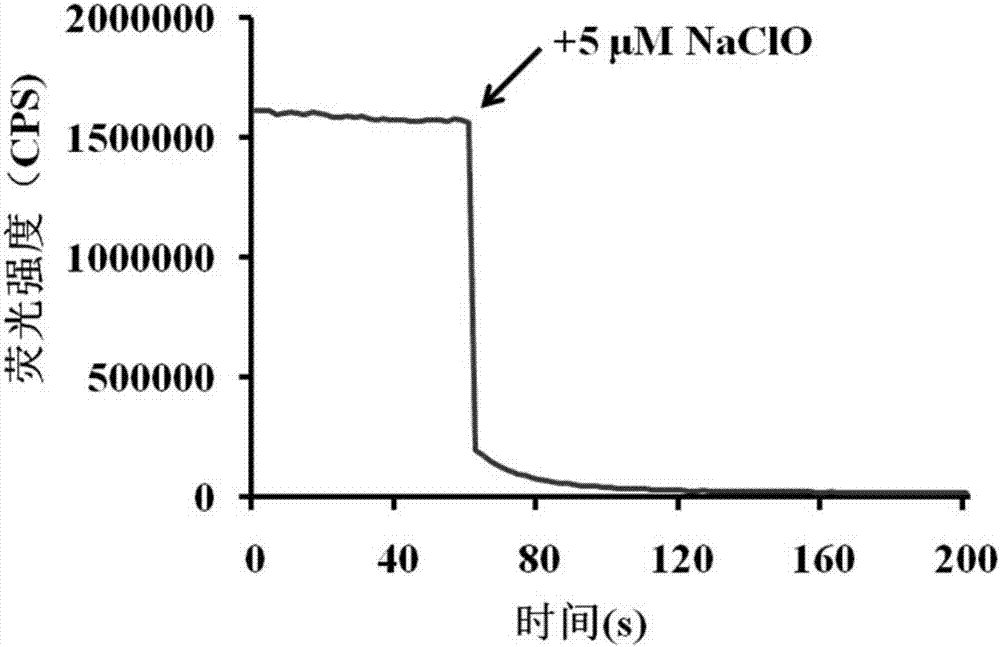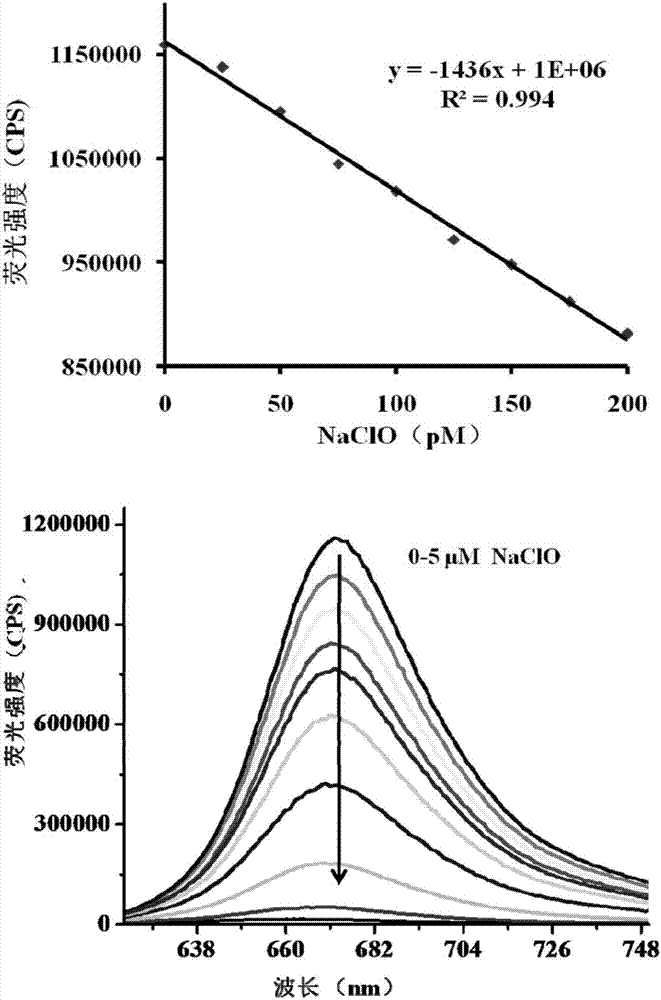Ultra-sensitive high-selectivity hypochlorite colorimetric fluorescent probe
A sulfonic acid group and compound technology, which is applied in fluorescence/phosphorescence, luminescent materials, material analysis by optical means, etc., can solve the problems of complex synthesis, poor selectivity and low sensitivity, and achieve simple synthesis, good stability and cost. low cost effect
- Summary
- Abstract
- Description
- Claims
- Application Information
AI Technical Summary
Problems solved by technology
Method used
Image
Examples
Embodiment 1
[0037]
[0038](Scheme 1) Dissolve p-nitroaniline (1.1 g, 8 mmol) in water and hydrochloric acid (v:v=5:5), add sodium nitrite and stir for 20 minutes at low temperature. 3-Hydroxy-N,N-diethylaniline (1.97,7 mmol) was dissolved in methanol, and the mixture was stirred at room temperature for 30 minutes. Then the dark brown solid was obtained by suction filtration. The dark brown solid (731mg, 1.7mmol) and 1-naphthylamine (243mg, 1.7mmol) were added with HOCl at 165°C under DMF reflux 4 (1 mL) was stirred for 15 minutes, then cooled to room temperature. The resulting mixture was treated with CH 2 Cl 2 extracted, washed with water, and then washed with anhydrous MgSO 4 dry. Purify v(CH by silica gel column chromatography 2 Cl 2 ) / v(CH 3 OH) (100:1, 50:1 to 25:1) to give a dark blue solid (130 mg, 23.8%).
[0039] (Scheme 2) Dissolve p-nitroaniline (1.1 g, 8 mmol) in water and hydrochloric acid (v:v=5:5), add sodium nitrite and stir for 20 minutes at low temperature. ...
Embodiment 2
[0044] The inventor of the present invention has carried out following test: (a) under the condition of PBS pH=7.4, different concentrations of sodium hypochlorite are to the influence of probe (20 μ M) solution color; (b) under the condition of PBS pH=5.0, different concentrations of sodium hypochlorite are to probe (20 μ M) the influence of solution color; Above-mentioned mensuration is carried out in the pure aqueous solution of 10mM PBS, and the probe used is the probe prepared in embodiment 1, and all spectroscopic tests are that NaClO adds effect under 25 ℃ measured after 1 min. See results figure 1 .
[0045] from figure 1 (a) It can be seen that the sodium hypochlorite whose concentration gradually increases under the condition of PBS pH=7.4 can make the color of the probe solution gradually become lighter; from figure 1 (b) It can be seen that the sodium hypochlorite whose concentration gradually increases under the condition of PBS pH=5.0 cannot change the color o...
Embodiment 3
[0047] Test results of the response time of the probe (5 μM) to NaClO (5 μM). The above determinations were carried out in 10 mM PBS, pH 7.4 aqueous solution, the probe used was the probe prepared in Example 1, and all spectral tests were measured at 25°C. See results figure 2 .
[0048] from figure 2 It can be seen that after adding an equal concentration of sodium hypochlorite, the fluorescence intensity drops suddenly, and the response can be completed within 20s.
PUM
 Login to View More
Login to View More Abstract
Description
Claims
Application Information
 Login to View More
Login to View More - R&D
- Intellectual Property
- Life Sciences
- Materials
- Tech Scout
- Unparalleled Data Quality
- Higher Quality Content
- 60% Fewer Hallucinations
Browse by: Latest US Patents, China's latest patents, Technical Efficacy Thesaurus, Application Domain, Technology Topic, Popular Technical Reports.
© 2025 PatSnap. All rights reserved.Legal|Privacy policy|Modern Slavery Act Transparency Statement|Sitemap|About US| Contact US: help@patsnap.com



